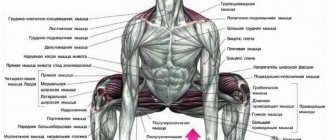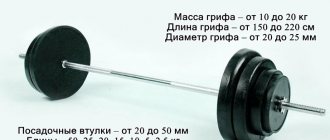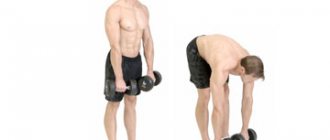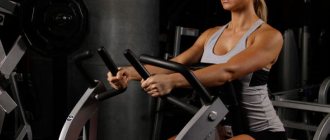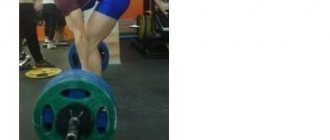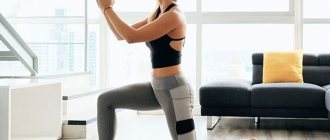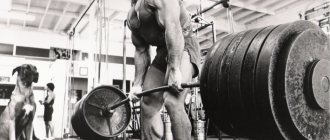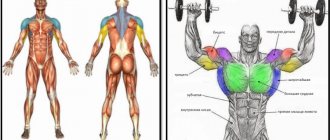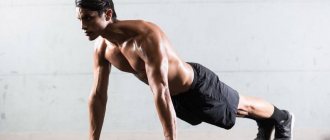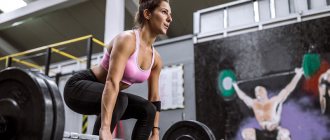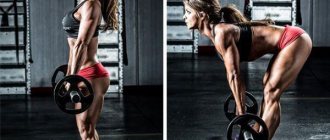Share:
What you need
- Barbell
- Platform
Deadlift is one of the most common exercises among all sports disciplines. It is actively used in powerlifting and crossfit, and is also a good auxiliary exercise for increasing the overall strength and power of an athlete, so mixed martial arts fighters, fans of boxing and oriental martial arts also do not bypass it, thereby gaining crazy strength and increasing their overall athletic potential. Today we will tell you how to do deadlifts correctly, as well as the main types, techniques, standards and alternatives to this exercise.
What is a deadlift? Theoretical basis. Types of deadlifts
The deadlift is one of the basic exercises that is performed with a barbell, sometimes a kettlebell or a dumbbell.
The performer stands in front of the apparatus, bends down, bending his knees slightly, takes and lifts the bar, slowly straightening up.
The deadlift, along with the bench press and squats, is one of the classic powerlifting disciplines. Proper execution allows the trainee to achieve good results in a few months and perfectly develops muscles. This challenging exercise works most of the muscles in your body, especially strengthening your lower back.
There are four types of deadlifts: deadlifts, that is, classic deadlifts, sumo deadlifts, and trap bar deadlifts.
Classic deadlifts are performed with narrow legs that barely touch the bar itself. During the exercise, most of the load falls on the back; the legs work only at the beginning, when lifting the apparatus. Typically, this type of deadlift is recommended for athletes with weak legs, small arms (in length) and short fingers.
This physique and anatomical features significantly affect technique, preventing the athlete from holding large weights for a long time. For best results, use a lock grip, with the knuckle of the thumb supporting the rest.
To minimize the risk of injury, some athletes use wrist straps that secure the barbell in their hands. It is important to know that they are prohibited in competitions.
Classic deadlift
“Dead lift” , or “dead lift”, is performed on straight legs.
When moving down, the legs remain straight. STRAIGHT! There is no need to squat slightly, although the knees can remain “soft,” that is, slightly bent in one position, throughout the exercise.
This deadlift cannot be used in powerlifting competitions due to the excessive amount of damage the athletes receive. When an athlete leans towards the apparatus and lifts it, he practically does not bend his legs, which puts a lot of stress on his knees.
If you're a beginner, hold off on deadlifts until you've mastered the classic ones.
Deadlift
The sumo deadlift is a straight-legged deadlift. When doing this, you need to spread your legs wide apart so that your toes barely touch the plates, and always keep your back straight.
This stance puts the most strain on the thigh muscles, which is why it is recommended for athletes with weak backs and long arms.
Sumo deadlift
The Romanian deadlift is a very popular exercise in both men's and women's circles, because... it works very hard on the back of the thigh – the biceps. Place the barbell on the supports at mid-thigh height. Grasp the barbell with an overhand grip at a distance slightly wider than shoulder width. Keep your knees slightly bent. Inhale, bend at the waist and begin to lower the barbell to the height of the middle of your shins. During this movement, move your pelvis back, as when performing a deadlift. Without stopping at the bottom of the exercise, begin to straighten.
Romanian deadlift
The trap bar deadlift differs little from the classic technique. The main differences are that the legs are placed wide, literally touching the plates, and the hands hold the bar with a narrow grip. This simplifies the last phase of the exercise (lowering the implement) and allows the lifter to lift more weight.
Trap bar row
"Dead" or Romanian deadlift
It is not used in powerlifting due to increased trauma and the inability to lift maximum weight. It differs from the classic deadlift in that the legs are straightened completely or almost completely throughout the exercise (determined by individual anatomical features). Width – shoulder level or narrower.
The technique of performing a “dead” deadlift is completely similar to the classic version. The specificity of the exercise is that the load is accentuated on the back and buttocks, the legs are involved to a lesser extent than in the classic version.
“Dead” deadlifts are practiced mainly by bodybuilders, in particular – Arnold Schwarzenegger used only “dead” (Romanian) deadlifts9, not classical ones, in his training.
Features of the deadlift:
- – The work is performed with light weight (individually up to 50-70% of the maximum).
- – The exercise is performed with a large number of approaches (from 3 workers) and repetitions (from 10).
- – It is permissible to lower the bar not all the way to the floor, but to the middle of the shin.
This variation is called a deadlift because ideally the legs should be completely straight and motionless. However, due to the lack of flexibility in the legs, athletes often allow a slight bend in the knees.
Main muscles involved
It is not without reason that the deadlift is recommended by all trainers as the main stimulator of body weight growth, along with the bench press and squats. When performing it, almost ¾ of all muscles work, mainly: back extensors, buttocks, biceps, muscles of the thighs, back, forearms and trapezius. The deadlift mentioned above also targets the hamstrings, giving them maximum stress, and the upper buttocks.
Main Muscles Worked When Deadlifting
Sumo or classic: the difference in technique
What is the difference between these two types of traction?
- Well, the answer is obvious: the position of the legs . Depending on the width of your legs, the height of the barbell changes. The wider the legs are spread, the lower the lifting height of the projectile. Those. By placing your feet wider, you simply make the task a little easier for yourself and reduce your range of motion.
- Typically, the classic deadlift is chosen by people with shorter legs and a longer torso. Still, the sumo style requires a certain flexibility and mobility in the hip and knee joints.
- The sumo deadlift engages all of the hip adductors more fully. The classic technique loads the back .
- Classic requires parallel placement of the feet. Sometimes trainers advise turning them slightly to the sides. When doing sumo deadlifts, your goal is to rotate your feet 45 degrees outward.
Both deadlift variations are equally good. If you are in doubt about the choice, experiment with both options. Only then will you be able to figure out what is more convenient for you to do. The sumo deadlift has its pros and cons, just like the classic one, so the choice between them is a purely individual matter and depends on your personal comfort.
Sumo deadlifts are usually more popular among women because... in this position, more load is given to the gluteal muscles. However, remember that while hip extension exercises like these do engage the glutes, they don't engage them fully—during a deadlift, the glutes are activated by 52%.
Warm-up for deadlifts
In any sport, use caution to avoid injury. Under no circumstances should you turn a blind eye to warming up before training, especially when you have just started exercising. Even running, which is so familiar to us, requires stretching our legs in order to reduce the risk of sprain or fracture as much as possible.
Basic exercises with apparatus require both warm-up and backup. And if error-free execution is the first pillar on which your future success rests, then warming up is the second.
Warm-up with small weights
First, stretch your joints and do some exercises. Do a dozen bends, a “mill”, stretch your wrists, elbow and shoulder joints. Next, warm up the tendons in the lower back to avoid tears and strains.
An excellent warm-up option would be stretching.
Do a couple of sets of deadlifts with light weights or an empty bar, and then gradually increase the load. It is also important to perform the exercise slowly, without rushing.
Health risks
Deadlift is an exercise that is both effective and dangerous if you do not follow the correct technique and force the growth of the weight.
Therefore, technique, technique and technique again!
Ideally, a personal trainer will help you master this exercise.
People who already have problems with the spine should treat the deadlift with caution.
The slightest pain or discomfort in the back is the reason why you should refuse to perform this exercise and look for other alternatives.
Technique for performing classic deadlifts
Competent execution of the exercise is the key to success. To avoid injury and achieve results, follow this plan:
Preparation
Preparation before performing a deadlift
Approach the bar and place your feet hip-width apart. It is important to take the correct position so that the weight is distributed evenly across all muscle groups. Often, for beginners, it turns out that the leg muscles are loaded more than the back. As for the placement of the socks, there are no fundamental differences. Usually their angle is selected individually, depending on how it is more convenient to lift the barbell.
Now let's talk about shoes for deadlifting, typical running shoes are not suitable. Sneakers or any other shoes with flat soles are preferable, making it easier to maintain balance and avoid overloading, leading to back pain.
Place emphasis on your heels, so that there is no tilt back or forward. When you start lifting the apparatus, do not straighten your knees suddenly and immediately. You should straighten up slowly to avoid injury.
Location
If you place the bar far away or, on the contrary, too close to your legs, then you risk injuring your back. It is necessary to stand by the apparatus so that it barely touches the shin, and during the exercise itself barely slides along the legs. Correct, literally symmetrical positioning of the legs will bring you the best results.
Symmetrical positioning of the legs, the bar slightly touches the shin
Without bending your knees, lower your body down and place your hands on the barbell so that your knees are inside (distance about 40 cm). Keep your arms straight. When lifting the barbells, always keep them vertical and do not bend them.
As for the grip, everything is standard here. Always use a pronated grip, that is, with your palms facing down, and do not resort to a mixed grip. The latter is rarely used, and only in competitions.
Proper Grip Types for Deadlifts
The shoulders should extend slightly forward beyond the line of the bar (imagine that your shoulder blades are covering the bar) - this will help to evenly load the shoulder joint. The head and neck should be in a neutral position, with the gaze directed forward.
Positioning of body parts during deadlift
As a beginner, bring the correct positioning to automaticity on an empty bar. Spend even weeks, but hone the technique to perfection, so as not to waste time later. It is highly not recommended to use heavy weights in the early stages.
Upward movement
Proceed with the first set of the series as soon as you understand the layout. Standing at the apparatus, straighten your back and arms. Slowly lower yourself without losing proper stance and grab the barbell.
Upward movement in deadlift
Push your chest forward, take a deep breath, and rise calmly and measuredly, keeping the barbell as close to your legs as possible. The snatch cannot be used, as it will bend your arms, which will increase the load on your back. In the first phase of the movement (raising the barbell to the knees), the front surface of the thighs is involved in the work, in the second - the back surface. If you lose your balance and can't lift the barbell smoothly, try reducing the weight and working the rack again. Remember that the center of gravity must be shifted to the heels.
Deadlift technique
As soon as the bar leaves the ground, press your feet harder and speed up the rise a little. The legs should extend at the same time and with the same force. Don't try to pull the weight solely with your back. After lifting the apparatus, arch your lower back (but not too much) and push your shoulder blades back.
Upper deadlift position
Moving Down
Lowering the weight begins not with bending your knees, but with pushing your hips back - this will help clear the way for the barbell, preventing it from hitting your knees. Lower the barbell in this manner to the position of your kneecaps, then begin to bend your knees. The bar should be lowered in a contiguous manner, without accelerating and making sure that the movements are smooth. You should spend at least 2 seconds returning to the starting position, as jerking can lead to injury.
After lowering the bar, take a couple of breaths (without changing position) and continue the approach. Set the number of lifts at a time yourself, as far as you have strength.
Technique Tips
To perform the exercise with maximum efficiency and avoid injury, follow these recommendations:
- Use locks
When working with a barbell, be sure to secure the weight with special locks on both sides. This will prevent them from falling during the approach and will help maintain symmetry.
- Eliminate “bouncing” from the floor
When the barbell hits the floor, there is always a temptation to go faster. Some students almost drop it on the floor. At the same time, the bar bounces off him, overloading the spine.
- Work slowly
You can lift the projectile up a little faster, but control at the moment of lowering is one of the most important moments when performing a deadlift.
Don't let your muscles relax, try to lower the weight 2 times slower than you raised it.
- Breathe evenly
Don't forget that for the body to work efficiently, it needs a sufficient amount of oxygen.
When going up, exhale, and when going down, inhale.
- Don't lean your back back at the top
Once you've lifted the barbell, don't lean back too much. Thus, you overextend the spine and can provoke injury.
- Increase weight gradually
Do not add another pancake unless you are sure that the technique has been perfected.
Deadlift for Beginners
It was already mentioned above in the article that not only basic exercises with iron, but any sport in general can cause injury. When visiting the gym for the first time, most beginners go to extremes. Some people immediately run to a dangerous exercise machine and perform the exercises incorrectly, harming their health, while others take up aerobic exercises or dumbbells and do not get off them for weeks, or even months. But the truth, as we know, is in the golden mean.
Once in the gym, it is best for a beginner to find a coach so that he can write out a program for him and estimate the possible starting weights based on his appearance. If there is none, and you cannot ask for advice, you should familiarize yourself with the correct technique from the appropriate sources. This also applies to deadlifts. It can be done by a beginner, but only with light weights or an empty bar. There is nothing wrong with this, since only the right technique can bring good results. Otherwise, you will only injure yourself.
Grip Features
Here, a straight grip is traditionally used, with the palms facing toward oneself. This option helps to involve the forearms to the maximum, develop a grip and engage the latissimus dorsi muscles.
However, in cases where the barbell is too heavy and a person cannot hold it in his hands (they involuntarily unclench), some use a mixed grip or a different grip.
This option is possible, but it should be remembered that it contributes to the uneven development of the left and right sides of the body, that is, symmetry is broken.
With prolonged use of this technique, a slight, but still curvature of the spine develops. In addition, grip strength does not improve.
You can also perform the exercise with a wide grip. It promotes additional activation of the upper back.
If you choose it, be sure to ensure that the shoulders do not round. In this position, it is more difficult to control them and keep the chest open.
Deadlift for girls
Should girls do deadlifts? Many representatives of the fair sex bypass exercise equipment with large weights such as bench press and deadlift, considering them exclusively male exercises. Obviously, this is a simple misconception. Deadlifts, like squats, work the muscles of the back and lower body, including the legs and buttocks.
All types of deadlifts work the hips, glutes, and lower back to varying degrees. Depending on the execution technique, a greater load can be placed on the lower body, which puts the deadlift on par with squats. Keep in mind that you should not deadlift if you have back problems. Consult your doctor and trainer before attempting deadlifts.
Advantages and benefits of back exercises
Rowing a barbell with straight or bent legs uses more than 73% of the muscles of the total body musculature. This means that the exercise allows you to develop not only the target muscles (buttocks, back or legs), but also auxiliary ones (arms, shoulders, abs). For the body, such an intense load is beneficial not only physically, but also physiologically. A powerful release of testosterone in men and girls helps strengthen the endocrine system.
Thus, the following advantages of deadlift can be identified:
- Exercise heals the body, speeds up blood circulation and tones the muscles.
- Deadlift involves working safely (subject to the rules of execution) with a barbell and large weights.
- The exercise helps build and sculpt muscle mass in the legs and back.
- Rowing a barbell or dumbbell strengthens the muscle tissue that supports and protects your internal organs.
- Deadlifts help fight excess weight.
- The exercise has many options: depending on your physical abilities or health limitations, you can choose a more gentle version of the deadlift.
Deadlifts must be included in the set of compulsory exercises in both men's and women's training. Whatever your goals, be it bulking, losing weight or cutting, barbell rows with straight or bent legs are great for achieving these goals.
Do you need insurance and seat belts?
Deadlift Safety Straps
If you are training purely for yourself and do not plan to compete, then you are unlikely to need insurance. Belts are typically used by athletes in tournaments to allow them to lift heavier weights. But for ordinary trainees, it is important to first perform the exercise without mistakes, so as not to get injured.
Deadlift harness
Unlike squats, deadlifts do not require two people to perform. In case of incorrect technique, severe pain or other force majeure situation, you can always throw the barbell, for which you do not need a spotter.
How to include deadlifting in your training program
The exercise can be performed on leg or back day if you do a split workout.
If you train Full body, that is, pump up all the muscles in one day, practice deadlifting 1-2 times a week.
It is better to put it at the beginning of the lesson so that you have the maximum amount of strength left to complete it.
When working to increase muscle mass, perform 3 to 5 approaches, 6-12 repetitions each. And be sure to start with warm-up sets, gradually increasing the weight on the barbell.
The working weight should be heavy enough, but so that the movement technique is not disrupted.
The deadlift is also widely used to increase strength. In this case, a submaximal weight is used for 3-5 repetitions per set.
The technical side of the deadlift. Errors, tips
- Do not start the exercise without warming up. Spend at least 5 minutes warming up your muscles to avoid injury.
- Basically, people with bad backs are prohibited from deadlifting. But sometimes it is permissible to work with low weights and an athletic belt, which will slightly reduce the risk of potential injury and reduce the load on the lower back.
- If you have already moved up to heavier weights, it makes sense to use chalk to prevent the bar from slipping.
- If the bar does not have threads on the ends, it is necessary to put on locks so that during the exercise some of the plates do not move. This can cause you to lose your balance and drop the projectile, resulting in a sprain.
- Do not make sudden movements when working according to the instructions.
- Listen to the advice of gym regulars, and especially the trainer. Instructions on the Internet are good, but sometimes it is better to look once than to read ten times.
Important points
- You need to lower and raise the barbell quite slowly and smoothly;
- The downward movement must begin by moving the pelvis back;
- The bar should slide along your thighs throughout the entire movement;
- The lower back should be arched;
- After passing your knees (downward movement), you need to touch the floor bar with the weights;
- Mentally imagine that instead of lifting up, you press your feet into the floor;
- Both during lifting and while lowering the barbell, you should not put your body weight on your toes . In this case, the bar will move forward from your legs and you can simply fall forward.
- Don't do deadlifts off the floor, i.e. don't throw her away. Even if you feel like you can't lift the barbell - under no circumstances leave her. Lower it, if possible, smoothly, so that the load from your back is removed not suddenly, but gradually. Sudden removal of the load can seriously injure the muscles of the back, elbows or shoulders.
By working back and forth, you make your work much easier and pass the critical point of removing the barbell at speed. The meaning of such training disappears. Additionally, “pounding” can cause the plates on one side of the bar to slide down the bar.
This will lead to loss of control of the barbell, asymmetrical lifting of the weight and uneven load on the body, which can lead to serious spinal injuries.
- Never twist your head when you lower or raise the barbell - the barbell may tilt slightly to the side, you will be pulled to the side, and you may injure yourself.
- Don't deadlift reps to failure, don't do forced or negative reps. In such a serious exercise as the deadlift, these experiments are not appropriate.
- Do not perform deadlifts if your lower back muscles are still quite sore from your last workout or even from regular heavy physical labor. Rest for a day or two and wait until the muscle pain goes away.
- Breathing: inhale – slowly down, exhale – up.
- Avoid the main mistake of rounding your back; to do this, try to look up.
Error in all its glory
